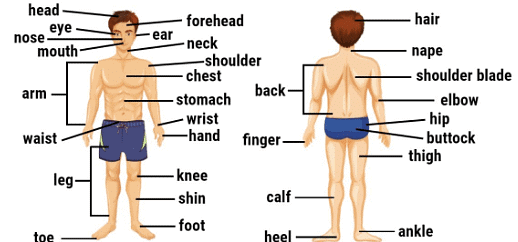Class 1 Exam > Class 1 Notes > Science Olympiad for Class 1 > Parts of the Body
Parts of the Body | Science Olympiad for Class 1 PDF Download
Human Body
- Our body is wonderful! We do all activity using our body. Thinking and our reasoning capability make us different from other living creatures of the earth. Our ability to communicate and think makes us human.
- Human beings have different body parts which perform different functions. There are five sense organs in the human body which help them sense things. Apart from sense organs human have some important organs like heart, brain, stomach, lungs etc.
- Our body has many parts and each one has different name and use. Let’s know the names of our body parts.
- We use our legs to kick, walk, skip, run, jump etc. We can wiggle our toes and fingers, write with our hands, lift things etc. While doing these things our body parts bends. Bending makes movement possible. All the places that bend in our body are called joints.
Parts of the Body

- Brain: We have seen a CPU in a computer system. Just like CPU is the processing unit of the computer system, our brain is the CPU of our body. Brain is present in the head of our body and is responsible for the activities of our body. Our brain gives instruction to all the other parts of our body. We are capable of thinking and memorizing due to the functioning of the brain only.
- Teeth: Teeth are white in colour and contain hardest substance present in the human body. They are present inside our mouth and are used for chewing and tearing the food. Humans have 20 milk teeth up to the age of 6 years whereas adults have 32 teeth which are the permanent teeth.
- Lungs: There is a pair of lungs in the human body present in the chest. Lungs assist us in breathing and purifying the blood.
- Heart: Heart is the pumping organ present in our chest. It is an internal organ of our body. A healthy person’s heart beats 70-75 times/minute.
- Arms: We are humans and all of us have a pair of arms. Each arm consists of an elbow, wrist, hand and fingers. Hands are used for various activities like eating, writing, combing, cleaning, etc.
- Legs: We can perform several activities with the help of our legs. The legs are present in the lower body part of our body. Activities like running, walking, dancing, etc. can be performed with the help of legs only.
The document Parts of the Body | Science Olympiad for Class 1 is a part of the Class 1 Course Science Olympiad for Class 1.
All you need of Class 1 at this link: Class 1
|
28 videos|85 docs|54 tests
|
FAQs on Parts of the Body - Science Olympiad for Class 1
| 1. What are the main parts of the human body? |  |
Ans. The main parts of the human body include the head, neck, torso, arms, and legs. The head contains the brain, eyes, nose, mouth, and ears. The neck connects the head to the torso, which consists of the chest, abdomen, and back. The arms are attached to the shoulders and include the upper arms, forearms, and hands. Similarly, the legs are attached to the hips and consist of the thighs, lower legs, and feet.
| 2. How many bones are there in the human body? |  |
Ans. The human body has 206 bones. These bones provide support, protect organs, store minerals, and produce blood cells. The skeletal system includes bones of various shapes and sizes, such as long bones (e.g., femur), short bones (e.g., wrist bones), flat bones (e.g., skull), and irregular bones (e.g., vertebrae). The bones are connected by joints, allowing movement and flexibility.
| 3. What are the major organs in the torso region of the body? |  |
Ans. The torso region of the body houses several major organs. The chest contains the heart, lungs, and major blood vessels. The abdomen contains organs such as the stomach, liver, gallbladder, pancreas, kidneys, and intestines. The back houses the spine, which protects the spinal cord. These organs work together to perform vital functions necessary for survival, such as digestion, respiration, and circulation.
| 4. How does the nervous system control the body? |  |
Ans. The nervous system is responsible for controlling and coordinating the body's activities. It consists of the brain, spinal cord, and peripheral nerves. The brain receives and processes information from the senses, initiates responses, and stores memories. The spinal cord relays messages between the brain and the body. The peripheral nerves transmit signals to and from different parts of the body. This complex network allows the nervous system to regulate movement, sensation, thoughts, and various bodily functions.
| 5. What are the major functions of the muscular system? |  |
Ans. The muscular system plays a crucial role in the body. Its main functions include providing movement, maintaining posture, generating heat, and assisting in bodily functions. Skeletal muscles enable voluntary movements, such as walking and lifting objects. Smooth muscles control involuntary actions, such as digestion and blood circulation. Cardiac muscles are responsible for the rhythmic contractions of the heart. Overall, the muscular system allows us to interact with our environment and perform essential actions for survival.

|
Explore Courses for Class 1 exam
|

|
Signup for Free!
Signup to see your scores go up within 7 days! Learn & Practice with 1000+ FREE Notes, Videos & Tests.
Related Searches


















